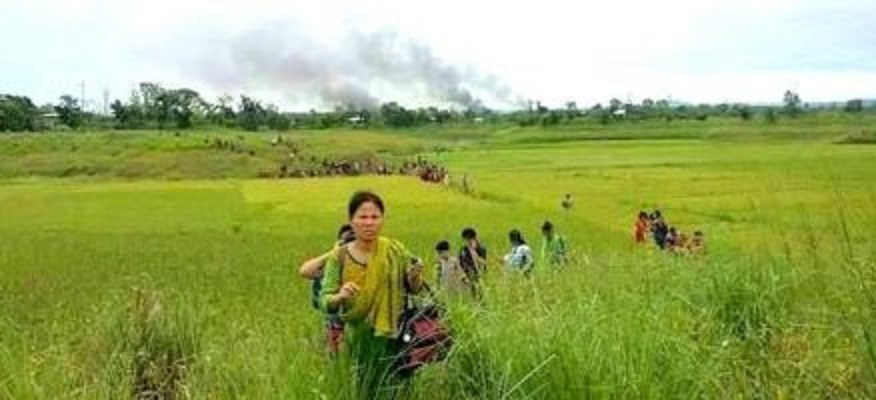
by Deep Green Resistance News Service | Jun 3, 2017 | Colonialism & Conquest
by Parbatya Chattagram Jana Samhati Samiti (PCJSS) via Cultural Survival
A massive communal and arson attack on four Jumma localities was carried by the Bengali Muslim settlers with the support of army and police in Longadu under Rangamati hill district of Chittagong Hill Tracts (CHT) on 2 June 2017. This organized and army-police-backed arson and communal attack claimed more than 300 Jumma houses burnt to ashes, of which it counts more than 200 houses and shops in Tintila of Longadu upazila headquarters and more 120 houses (around 40 houses in each of the three villages) in Manikjorchara, Battya Para and Baradom villages to have been completely burnt down. It is reported that at least an aged woman named Guna Mala Chakma (75) w/o late Rabichan Chakma was killed in this arson attack. Parbatya Chattagram Jana Samhati Samiti (PCJSS) expresses strong protest and condemnation over the setting fire and looting in the houses of indigenous Jumma peoples and massive communal attack.
It is learnt that centering recovery of a dead body identified to be of a driver of motor cycle Nurul Islam Nayon in Khagrachari, a belligerent procession of the Bengali Muslim settlers from Battya Para of Longadu upazila took to street under coverage of the army and police forces around 9:00 am. When the procession reached at Longadu upazila headquarters around 10:00 am, the settlers from within the procession began looting and setting fire in the Jumma houses and shops including the PCJSS office without any provocation. At this, 200 houses and shops belonging Jumma people got burnt down. Afterward, the Bengali Muslim settlers left for nearby Manikjorchara to attack the village under army and police force protection. At this, around 40 houses of the village were completely reduced to ashes.
The local administration promulgated Section 144 around 12:00 noon. But it was learnt that despite being so, the settlers moved ahead under army-police guard and set fire in the villages of South Manikjorechara, Battya Para, Boradam, etc. Jumma localities and these were being carried out at the time of origination of this report. In this attack, 30/35 houses in Battya Para and 40 houses in Boradom villages were burnt to ashes.
On receipt of the news of setting out a procession with the dead body last night, the local Jumma public representatives and leaders called on Longadu army zone and Longadu police station authorities to apprise their sense of danger and lacking of security. This morning, the 2nd-in-Command (2IC) Major Rafique of Longadu army zone assured on behalf of the army zone saying: “Staging procession is a democratic right of the settlers. They will exercise their right peacefully. No untoward incident will be allowed to happen. Hence, there is nothing to be worried.” Saying so, the commander assured the local Jumma public representatives and leaders, but it is a great irony that the settlers carried out organized attacks, looted and set fire in the Jumma houses and shops in all time presence of Longadu Zone Commander Lt. Col. Abdul Alim Choudhury psc, 2IC Major Rafique and Officer-In-Charge (OC) of Longadu police station Mominul Islam along with the joint forces.
It is learnt that the militant procession of the settlers was also participated by the national parties irrespective of their ideologies and differences, such as, ruling Awami League, BNP, Jatiya Party, Jamat-E-Islam etc. including the so-called Parbatya Chattagram Samo Odhikar Andolan (CHT Equal Rights Movement) and other upstarts organizations of the settlers. As part of their solidarity, Juba League, youth wing of the ruling party, organized a procession at 11:00 am today in Rangamati town in protest against killing of the said motor bike driver. It has been reported that anti-Jumma communal slogans were shouted during the demonstration.
Despite assurance given on part of the army and police authorities, the unabated looting and arson attack in the Jumma houses in the very presence of the authorities who ensured verbal assurance, it can safely be concluded that the Bengali Muslim settlers procession with the dead body has been a deliberate one in orchestration of the army-police forces and local leadership of the ruling party.
PCJSS considers this sort of organized communal and arson attack that happened today, has been conducted with the support of state machineries and local leadership of the ruling party to evict the Jumma people from their ancestral lands, to obstruct the implementation process of the CHT Accord, and over all to achieve their mean objective of turning the CHT region into a Muslim-dominated region.
The PCJSS, calls upon all the parties concerned to stop the army-police-backed communal and arson attacks by the Bengali Muslim settlers and to step up legal measures to bring all those army-police personnel and settlers responsible for the attack, looting and arson in the Jumma houses and shops, on an emergency basis.
Illegal search in the house of PCJSS leader & harassment of family members by the BGB in Kaptai
In a press release signed by Assistant Information and Publicity Secretary of Parbatya Chattagram Jana Samhati Samiti (PCJSS) Sajib Chakma dated 1 June 2017, PCJSS strongly protested against illegal search in the house of Areise Marma, President of PCJSS Raikhali Union Branch and and ill-attempt of planting explosive materials inside the house, beating and undue harassment upon his family members.
PCJSS says, a BGB troop of 19 Battalion from Wagga BGB Zone and Dongchari BGB camp entered the No.1 Para of Narangirimukh under Kaptai Upazila of Rangamati Hill District and conducted a thorough search in the house of Areise Marma (55), President Mv Raikhali Union Branch of PCJSS at the wee hours of today, 1 June 2017. It was learnt that the BGB searching party handcuffed Mathuiching Marma, wife of Areise Marma and slapped their daughter Unuching Marma.
As per the statement on the occurrence, the BGB personnel surrounded Areise Marma’s house at 01:30 am and having waken up the inmates of the house, began their search and this continued till 4:00 am. The BGB searching party were looking for Areise Marma who was not at home by then. At certain point of their search, Unuching Marama, daughter of Areise Marma noticed the BGB personnel digging the inside floor by theft and planting some explosive materials taken out from their bag that they carried along with and soon she offered challenge saying that it was they who brought in those articles, which were never part of their household objects. The BGB person concerned, for being unsuccessful, got tempered and slapped Unuching Marma with might.
At certain phase of searching, the BGB personnel locked Mathuiching Marma, wife of Areise Marma with handcuff. They entered into the bedroom of Areise Marma’s son and daughter-in-law and muddled the household articles including the wears and all. They snatched the mobile phones from the family members and mounted heavy pressure upon them seeking to know whereabouts of the arms and show the cached arms to them. The BGB kept them under threatening of sending to jail and filing up cases against them, if they did not show the location of the arms. The BGB personnel did not let them go to bed and harassed all the family members outside their house till 4:00 am. While leaving around 4.00 am they BGB wrote a note in a piece of white paper stating that nothing was done to the family members and made Unuching put her signature in the paper.
The PCJSS strongly protests against such conspiring and ill-attempt of planting explosive materials inside the house of Areise Marma, President of PCJSS Raikhali Union Branch, beating and undue harassment upon his family members and demands immediate stop to such conspiring and illegal searching.
It is worthy to be cited here that a group of BGB personnel from Wagga BGB Zone arrested No.4 Raikhali Union Council member and also Vice-President of PCJSS Raikhali Union Committee and his son Kyawhing Hla Marma, President of Kaptai Thana Branch of Pahari Chhatra Parishad by unknowingly planting explosive materials inside their house on 31 March 2017. They were taken to Rangamati Amy Zone and brought out heavy inhuman torture upon them. The BGB and Army Zone authorities made the severely wounded father and son say what they were taught to confess to the local press media.
In recent days, searching operation elsewhere by army and BGB, filing up false-based and fabricated cases entangling the Jumma people including the PCJSS members engaged in the movement for rights and implementation of the CHT Accord, taking the arrested by secretly planting fire arms and sending to jail, meting out physical torture and harassment have become a very common scenario with intensity. The PCJSS has the ground to believe all this design to have been being directed to achieve mean objectives of identifying the just movement for implementation of the CHT Accord as an act of terrorism, destroying the dynamic leadership of PCJSS and over all, to obstruct the implementation process of the CHT Accord and to utter surprise to note that the atrocities upon the members of PCJSS and its associate organizations are being meted out by the army-BGB-police forces with the support of the ruling party, the misdeeds of which can never yield in wellbeing to the national interest.
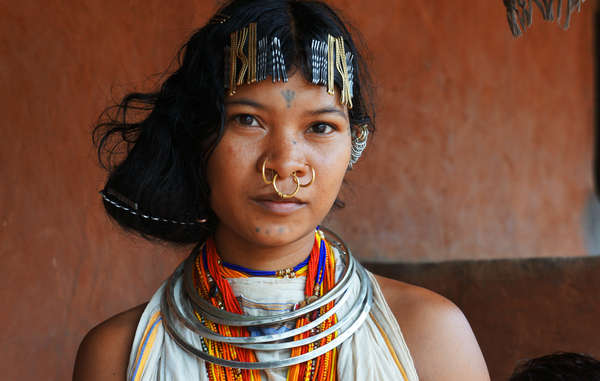
by Deep Green Resistance News Service | May 10, 2017 | Colonialism & Conquest, Mining & Drilling
Featured image: The Dongria have resisted attempts to mine in their hills for years, but are facing serious pressure to give in. © Survival International
by Survival International
The Indian government is harassing and attempting to silence the leaders of the Dongria Kondh tribe, famous for winning a “David and Goliath” court battle against a British mining giant.
The Dongria’s resistance to mining on their lands has continued since their landmark victory in 2014. Leaders including Dodi Pusika feel that the risk of mining remains as long as a refinery is operational at the foot of the Niyamgiri hills, an area which the tribe have been dependent on and managed for generations. A recent protest at the refinery was met with a baton-charge from police.
Pusika’s daughter-in-law, Kuni Sikaka, was arrested in the middle of the night of May 3 and accused of links with armed Maoist rebels. In exchange for her release, Dodi Pusika and other members of his family were made to “surrender” as Maoists and paraded in front of the media.
There has been an alarming increase in arbitrary, politically motivated arrests of tribal people who are resisting mining operations or government policies which endanger their lands and communities. Typically, those arrested are accused of Maoist links – usually without evidence.
Human rights activist and doctor Binayak Sen and tribal teacher Soni Sori have both been imprisoned for alleged Maoist connections and only subsequently released after national and international campaigns.
In April, the Home Ministry issued a report claiming that Maoists were “guiding the activities” of the Dongria’s organization, the Niyamgiri Suraksha Samiti (NSS). On the contrary, Maoists instructed the Dongria to boycott the very meetings at which they delivered their decisive “no” to mining.
Lingaraj Azad, a member of the NSS, stated, ‘We have always opposed violence – either State violence or Maoist violence. We will not bow down, but continue our struggle to protect Niyamgiri from being mined.’
Survival International is calling on the government to drop these fabricated charges, stop this persecution of the Dongria Kondh, respect their decision about the Niyamgiri mine, and to uphold their right to protect their lands and determine their own futures.
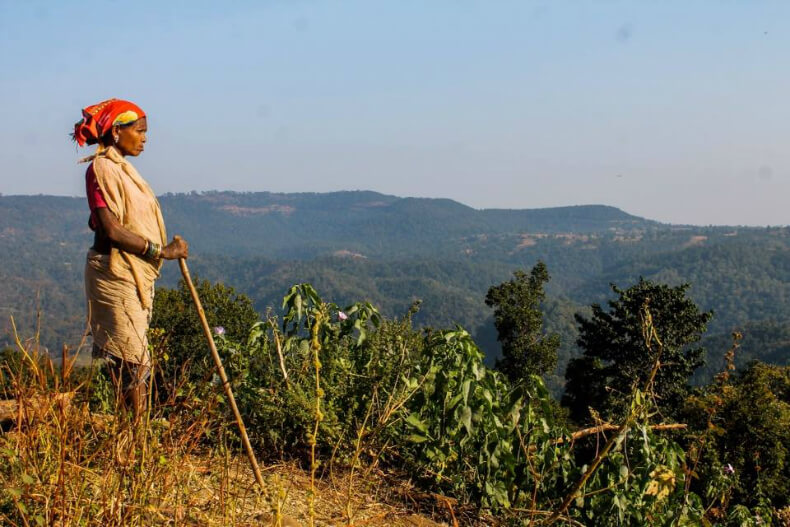
by Deep Green Resistance News Service | Apr 30, 2017 | Colonialism & Conquest
Featured image: A Baiga woman surveys the land in Amaniya panchayat, Chhattisgarh, much of which falls in the area of the proposed tiger corridor between Kanha and Achanakmar National Parks. In the tribal belt of central India, indigenous communities are being manipulated, evicted, and impoverished in the name of conservation. Photo: Heera Bai.
by Heera Bai / Intercontinental Cry
Throughout India today there are a total of 645 Adivasi communities recognized by the government. With a combined population of about 70 million, these communities maintain an impressive array of cultural identities, languages, customs and economies that go back millennia. But despite their resilience and their relative isolation from the perils of extreme extraction, Adivasis—the Hindi term for Indigenous Peoples—have not been able to escape any of the hardships that other Indigenous Peoples so often face around the world.
Across the Tribal Belt of Central India, where 90 percent of the population is still completely dependent on agriculture, indigenous communities are constantly being evicted from their ancestral lands to make way for development projects, industry, tourism and government-sanctioned conservation initiatives.
In the states of Madhya Pradesh and Chhattisgarh, the Baiga community have faced a legacy of evictions that dates back more than 30 years. They are constantly being forcefully, and often illegally, relocated from their fields and villages that live in and around the borders of the Kanha and Achanakmar National Parks.
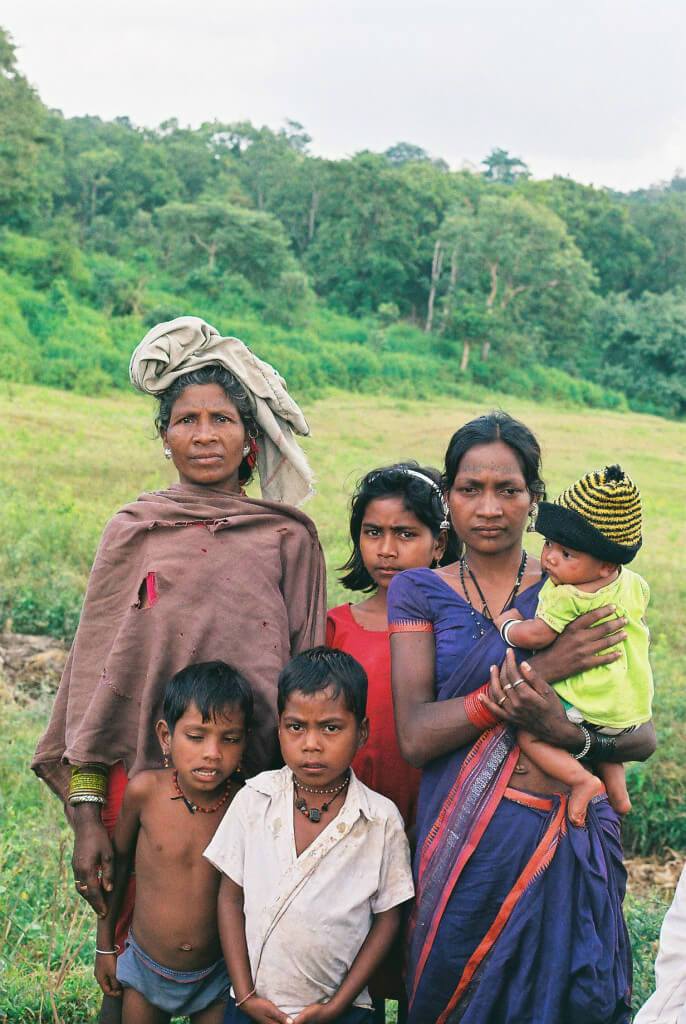
Women from Hirapur, a Baiga village which was relocated from Kanha National Park in the 1970s. “This lush green jungle – we can only see it, but we cant touch it. We cant take anything which was our traditions, our daily bread, it was everything to us. Our rights are written down in a book but we are illiterate.” Photo: Heera Bai
The Baiga are classified as a Particularly Vulnerable Tribal Group (PVTG) by the Indian Government, and the present adult generation had little access to education. The majority are illiterate and know no other language than their regional dialect. Their villages are incredibly isolated, accessible only by foot or motorbike on tracks through the forest. The distance between these villages makes cross-community solidarity or resistance logistically difficult, increasing their vulnerability to exploitation.
Until recently, the Baiga community was dependent on the jungle and the surrounding environment for survival. However, they existed in a symbiotic relationship with the forest generously providing them with everything they need including food, ‘jhari-booti’ (jungle medicine) and wood to build homes and tools. However, after decades of increasing rules and restrictions placed on their access to forest resources and the criminalisation of practices such as ‘bewar’ (shifting cultivation), their way of life has become increasingly difficult to maintain.
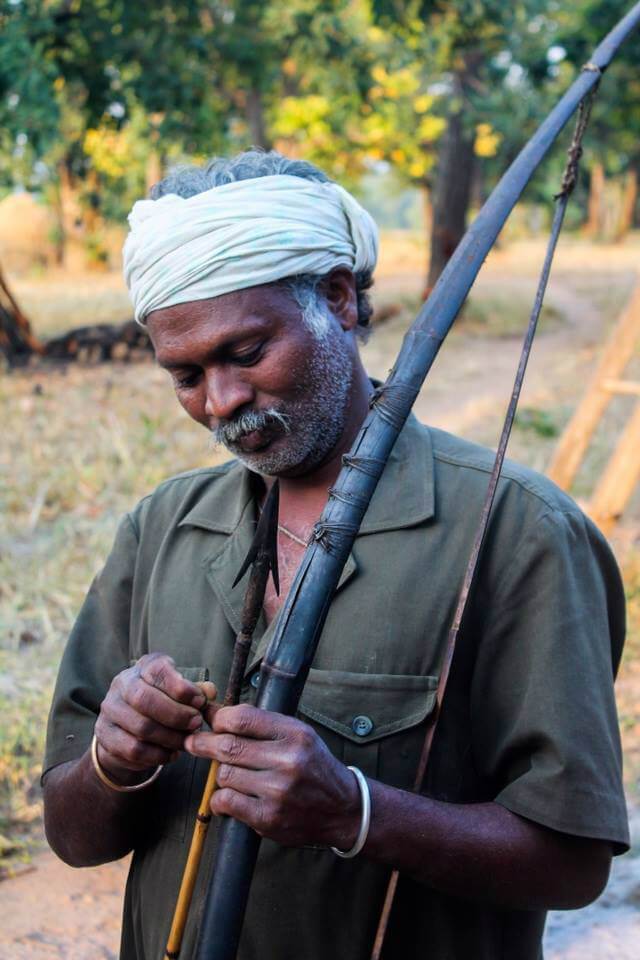
Noonsari, the makeshift village of displaced Baiga adivasi, in Mawai district Madhya Pradesh. This is a dhanoosna, a weapon used by their ancestors for hunting in the jungle. It takes a whole day to make a single arrow from peacock feather and cartilage. Photo: Heera Bai
“For us, only the jungle for us is good,” Bazaari Singh Baiga of the Peepatola village in Chhattisgarh said. “We don’t want fields or houses in another place. We want to stay living in the jungle, we don’t want to move to a city, where would we get wood from? We get everything we need from the jungle. If we moved from here we would die very quickly! We don’t buy things, we take everything from the jungle and make things ourselves with our own hands.”
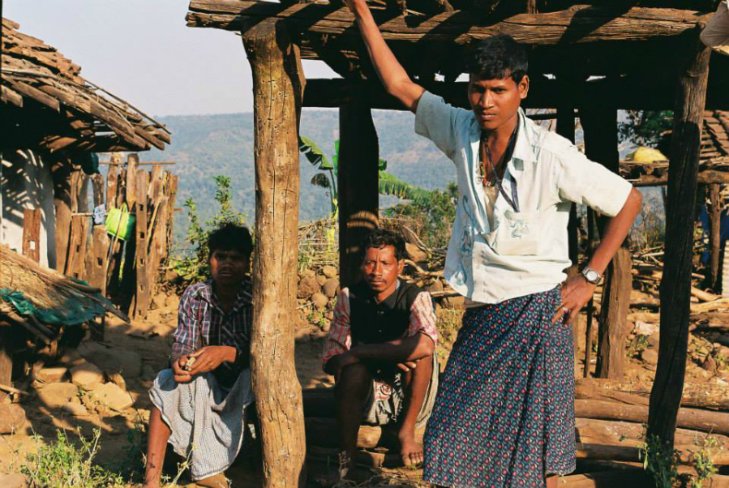
“We don’t want fields or houses in another place. We want to stay living in the jungle, we don’t want to move to a city, where would we get wood from? We get everything we need from the jungle,” says Bazaari Singh Baiga. Photo: Heera Bai
All Baiga villages in Kanha National Park in Madhya Pradesh have been displaced. The evictions began in the 1970s and the last five villages were evicted in 2013. It is a legal requirement that villagers give free, informed consent to the relocation of their village, but consent is forcefully taken after threats, harassment and manipulation.
“The Forest Department came and told us that if we don’t leave willingly they will bring elephants to trample our homes and fields,” Shakti Baiga said. Baiga lived in Benda, one of the last villages in Kanha evicted in 2013. “They brought documents into the village and made us sign it. But we’re illiterate, how could we have known that we were signing our land away?
“I had 5 acres of land in Benda. Here, I could only afford to buy 1.5 acres to support my whole family. I could only afford this land because chances are, this village will be also displaced in the near future. A new [Bhoromdeo] Wildlife Sanctuary has now been created and the fences are starting to go up around the village… There are only two families from Benda here, I don’t see any of the original community anymore.”

“How could we have known that we were signing our land away?” asks Shakti Baiga. Photo: Heera Bai
There is a strong World Wildlife Federation (WWF) presence in both parks. The infamous panda logo is seen in across the region, from the gates of the national park to small forest villages on the edge of the buffer zone. Despite denying any vested interest in tourism in Kanha, they offer $8,995 ‘tiger tours.’’ Survival International has confronted them about their complicity in illegal evictions in the National Park, but they have denied the illegality of these displacements.
The Forest Rights Act, implemented in 2006, supposedly recognizes ‘any traditional right customarily enjoyed’ by any ‘forest dwelling Scheduled Tribes’ or ‘Traditional Forest Dwellers’. These rights include not only those of forest habitation, but also ‘the right to cultivate for their livelihood, the right to collect minor forest produce, the right to graze cattle, the right to convert leases or grants (pattas) to titles, the right to manage the community forest resources, and the right to enjoy any customary/traditional practice.’
The Forest Rights Act also stipulates procedures for evicting a community from its land. The Panchayat Extension to Scheduled Areas (PESA) means that the Gram Sabha (village level decision making body) must give full, informed consent to the displacement. The community are supposed to be given three options: 1) Reject the eviction and stay on their land, 2) Agree to the eviction, and accept 10 lakh Rs in compensation, or 3) Agree to eviction, and move to a government provided Resettlement and Rehabilitation site.

Maki Bai and Sombati Bai from Ajanpur (displaced, now squatting on land in Bhari village, Madhya Pradesh) “All the land that was ours before, where are we going to find that now? We won’t find it. we were the kings of the jungle, but here they treat us like dogs. It’s only sadness here. We can’t even taken wood. Our lives are like dogs!” Photo: Heera Bai
There is no evidence in any of the Baiga villages evicted in the Kanha National Park were given any choice in the relocation, no village was given the option to stay. Even when a rejection is given, this is manipulated; a ‘no’ at the village level gram sabha becomes a ‘yes’ at higher levels of government.
In recent years, the government has run out of state land around Kanha National Park to offer the evicted communities as part of a Resettlement and Rehabilitation package. Villagers from Johar, Benda and the three other villages that were evicted in 2013 received just 10 lakh per adult male, in compensation (women and children under 18 are entitled to nothing). Now, they are struggling to find land that they can afford to buy and the communities have scattered across the region.
In the second park, Achanakmar National Park in Chhattisgarh, there are still 19 tribal villages inside the Core Zone, and many more in the Buffer Zone. So far, five villages have been evicted from the Core, and five more have been given their eviction notice. Those evicted were rehabilitated in resettlement villages on the outskirts of the National Park, where the concrete houses and the dusty road is a far cry from the lush green surroundings they left behind. They were promised five acres of land, a home, a village school and two years of paid work. The fields are drying up after just two harvests, after two years the school building is still awaiting completion and the promised work is yet to materialise. Men of the village are starting to go to distant cities like Lucknow in order to find menial, exploitative daily wage labour.

“If we have no choice but to leave Rajak, then we will only be relocated to Jhiriya Behera,” says Ramcharan Baiga. Photo: Heera Bai
Villagers still living in the forest have seen the resettled villages and refuse the offer of relocation. In Rajak, a core zone village, the villagers are unanimous in their rejection of the displaced and the proposed resettlement site. “Of course we want to stay in our village,” Ramcharan Baiga, a residents of Rajak, said. “If we can stay, then we will. We have told the District Collector that we will not go to Bharatpur because the land there is not sufficient to support our families. If we have no choice but to leave Rajak, then we will only be relocated to Jhiriya Behera.” The District Collector is refusing this compromise and insisting that the villagers have no choice in their resettled location.
The National Tiger Conservation Authority (NTCA), Ministry of Environment and Forests, have recently and surreptitiously passed an order stating that:
“In absence (of) guidelines for notification of critical wildlife habitats, no rights shall be conferred in Critical Tiger Habitats which is duly notified under the Wildlife (Protection) Act 1972.”
The Forest Rights Act states explicitly that the rights conferred within apply to all forest areas without exception; therefore the attempt by the NTCA to bypass this is illegal, and will be devastating for the communities affected. There is mounting evidence that suggests that the presence of Adivasis in critical wildlife habitats, including tiger reserves, is in fact conducive to preserving and managing these areas of biodiversity.
In addition to this, there are also plans to create a ‘tiger corridor’ between Kanha and Achanakmar. There are over 700 villages in the proposed area, and many residents do not even hold the most basic land titles. Their evictions will be quick and they will have no grounds to resist. WWF and the state government have assured people that there will be no evictions in the area, but local people do not believe this at all. There are villages about every 7 km in the proposed corridor area, meaning that tigers will not be able to move through the ‘corridor’ without presenting a huge threat to villages. Therefore locals have come to conclusion that the reassurances they have had about there being no evictions are not true.
“That’s what they said when Kanha became a national park, they said the same for Achanakmar. They have already started putting up fences and restricting people’s access to the forest,” said Naresh Bunkar, a local man who was been working with adivasi communities in the region for 30 years. “It’s all lies. Slowly slowly, everyone here is going to be evicted.”
Heera Bai is a freelance journalist who works at Brush & Bow, a platform for creative journalism, working on documenting individual stories through art and music. Follow them at brushandbow.com and on Twitter @brushandbow2
by Deep Green Resistance News Service | Mar 30, 2017 | Colonialism & Conquest
Featured image: Dozens of people have been shot on sight by park guards in Kaziranga, including severely disabled tribal man Gaonbura Killing. © BBC
by Survival International
Survival International has called on the UN expert on extrajudicial executions to condemn shoot on sight conservation policies.
In a letter to the Special Rapporteur charged with the issue, Survival stated that “shoot on sight policies directly affect tribal people who live in or adjacent to ‘protected areas’… particularly when park guards so often fail to distinguish subsistence hunters from commercial poachers.”
The letter adds that “nobody knows when wildlife officers are permitted to use lethal force against [suspected poachers], and it is impossible for dependents to hold to account officers whom they believe to have killed without good reason. Many countries have gone further, and granted wildlife officers immunity from prosecution.”
The letter cites Kaziranga National Park in India as an especially striking example of the tactic. According to a recent BBC report, an estimated 106 people have been extrajudicially executed there in the last 20 years, including one disabled tribal man who had wandered over the park boundary to retrieve cattle.
Kaziranga guards have effective legal immunity from prosecution, and have admitted that they are instructed to shoot poaching suspects on sight. This has had serious consequences for tribal peoples living around the park. In June 2016, a seven-year-old tribal boy was shot and maimed for life by guards.

Akash Orang is comforted by his mother after being shot by a park guard. He is now severely disabled. © BBC
Similar policies are used in other parts of the world, notably Kenya, Tanzania and Botswana, among other African countries.
Speaking about his own anti-poaching work in Africa, poaching expert Rory Young from the organization Chengeta said: ”Shoot on sight is stupid. If we had been shooting on sight during this latest sting operation we would have shot a handful of poachers and that would have been the end of it. Every single poacher is an opportunity for information to get more poachers and work your way up the chain to the ringleaders.”
Survival has asked the Special Rapporteur to clarify that shoot on sight violates fundamental rights enshrined in the UN’s Civil and Political Rights Covenant and other international conventions. It also urges the UN to enquire about the policy with the Indian government, and the government of Assam state, where Kaziranga is located.
Shoot on sight is justified on the grounds that it helps to deter poachers. However, there have been several recent cases of guards and officials at Kaziranga being arrested for involvement in the illegal wildlife trade themselves.
Survival International is leading the fight against these abuses, and calling for a new conservation model that respects tribal peoples. Targeting tribal people diverts action away from tackling the true poachers – criminals conspiring with corrupt officials. Targeting tribal people harms conservation.
Survival’s Director Stephen Corry said: “If any other industry was guilty of this level of human rights abuses, there would be an international outcry. Why the silence when conservationists are involved? Torture and extrajudical killing is never justified – the law is clear on this. Some people think that the death of innocents is justified, that ‘collateral damage’ is necessary in the fight against poaching. We ask them, where is your humanity? Of course, there’s a racist element at play here: Shoot on sight policies would be unthinkable in North America or Europe.”
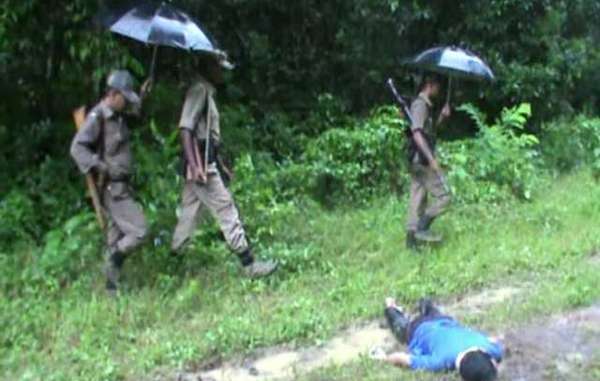
by Deep Green Resistance News Service | Feb 16, 2017 | Colonialism & Conquest
Featured image: Kaziranga park guards are heavily armed and instructed to shoot intruders on sight. © Survival International
by Survival International
A BBC investigation has revealed that tribal peoples living around a national park in India are facing arrest and beatings, torture and death under the Park’s notorious “shoot-on-sight” policy.
The report for television, radio and the BBC news website featured interviews with park guards, tribal people who have been affected by the policy in Kaziranga National Park, and a spokesman from WWF-India, which helps fund, train and equip park guards and advertises tours of the park through its website.
The park gets over 170,000 visitors each year. Fifty suspects were extrajudicially executed there in the last three years, and a severely disabled tribal man was shot dead in 2013. The BBC has estimated that 106 have been killed in the last 20 years. In the same period, only one official has been killed.
The BBC interviewed one local man who had been beaten and tortured with electric shocks during a detention by park officials before they realized he had no involvement in poaching.
The program also featured Akash Orang, a seven-year-old tribal boy who was shot in the legs by park guards last July. Akash said that: “The forest guards suddenly shot me” as he was on his way to a local shop. His father said: “He’s changed. He used to be cheerful. He isn’t any more. In the night, he wakes up in pain and he cries for his mother.”
Park guards have effective immunity from prosecution and are encouraged to shoot suspects on sight – without arrest or trial, or any evidence that they might have been involved in poaching. One guard admitted that they are: “Fully ordered to shoot them, whenever you see the poachers or any people during night-time we are ordered to shoot them.”
WWF has provided equipment – including what the BBC calls “night vision goggles” – which have been used in night-time operations and “combat and ambush” training. When asked by the BBC how donors might feel about their money being used to enforce this brutal treatment, WWF India’s spokesman said that: “What is needed is on-ground protection… We want to reduce poaching and the idea is to reduce it with involving other partners.”
Survival International is leading the global fight against these abuses and first brought the park’s high death toll and serious instances of corruption among Kaziranga officials – including involvement in the illegal wildlife trade they are employed to stop – to global attention in 2016.
Survival’s Director Stephen Corry said: “Conservation organizations, including WWF, are supporting a model of conservation which is resulting in gross human rights abuses. They have failed to condemn policies that are leading to widespread extrajudicial executions. For too long, conservation has relied on its positive public image to hide its horrific and sustained attacks on indigenous and tribal peoples’ rights. We’re working to stop this. It’s time for conservationists to work with tribal people, the best conservationists and guardians of the natural world. It’s time for conservation organisations to call for an end to shoot on sight policies.”











